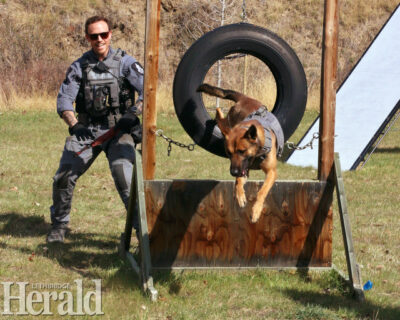Police dog Brandon officially on the job with LPS
By Lethbridge Herald on April 16, 2025.
 Police Service Dog (PSD) Brandon goes through the hoops with his trainer and partner Const. Terry Fieguth during his graduation ceremony on Tuesday at the Lethbridge Police Range.
Herald photo by Joe Manio
Police Service Dog (PSD) Brandon goes through the hoops with his trainer and partner Const. Terry Fieguth during his graduation ceremony on Tuesday at the Lethbridge Police Range.
Herald photo by Joe ManioJoe Manio – LETHBRIDGE HERALD
Tuesday was graduation day for the Lethbridge Police Service’s newest member. Unlike the pomp and ceremony of his two-legged colleagues at the police academy, Police Service Dog (PSD) Brandon gets to go through the hoops with his partner, Constable Terry Fieguth, in front of a crowd of colleagues and guests. Brandon, a nearly two-year old Belgian Malinois, joins the ranks of three other K9s currently serving in the LPS.
Before demonstrating his chops on the agility course at the K9 training area, PSD Brandon officially received his badge from LPS Police Chief Shahin Mehdizadeh.
“Anyone who thinks dogs are cheaper than people are wrong,” Mehdizadeh said, describing their value and how even off the clock, policing is a 24/7 job. “Off-duty, they go home with their partners.”
Brandon began his rigorous training program alongside Const.. Terry Fieguth on Jan. 6. While the training usually takes 20 weeks to complete, the duo was able to finish in 14 weeks since Cst. Fieguth is already an experienced K9 handler.
“I didn’t think a bond could be established as quickly,” Fieguth said, talking about the bond with his previous partner, a German Shepherd named Zap. “Brandon is my fifth child. He’ll keep me busy.”
Fieguth’s previous partner, PSD Zap, retired in November. Together, Brandon and Fieguth have been developing skills in tracking, obedience, agility, building searches, compound/area searches, evidence searches and criminal apprehension. Brandon will also continue to enhance his training in drug detection.
Even before beginning his law enforcement career with the LPS, Brandon had an interesting journey. Born in Spain, he travelled as a puppy to the Alabama Canine Law Enforcement Officers Training Center, and from there into the ranks of the LPS.
Police K-9 units perform a wide variety of duties, including detecting drugs and explosives, locating missing persons, finding evidence, and protecting officers. They are also trained to track suspects, search buildings and apprehend individuals.
“Their ability to do what no humans can do, makes them invaluable,” Fieguth said, referring to a dog’s sense of smell. “There’s nothing better than when your dog is responsible for finding someone.”
Police K-9 dogs face various hazards on the job. In 2024, 18 police dogs died in the line of duty in Canada, according to the Officer Down Memorial Page. The causes of death included gunfire, stabbing, duty-related illness, exposure to toxins, fire, heatstroke, being struck by vehicles, training accidents and vehicular assaults.
Since the inception of the police service dog program in 1964, 33 dogs have served the LPS. None have been lost in the line of duty PSD Brandon joins the ranks as the 34th – filling out the four K9 teams actively working alongside our frontline patrol teams and Critical Incident Team.
The average career of a police K-9 is typically between six and nine years. Many police dogs are retired at seven or eight years of age. Retirement can also occur earlier, if a dog becomes injured or is unable to continue working due to age, sickness, or through pregnancy.
Chief Mehdizadeh said retiring police dogs are given a ceremony and retiree supports in their new roles.
“They go from working dogs to pets,” said Mehdizadeh.
16-15

